In this special preview of the May 2016 issue just sent to subscribers, Ron Spomer explains why lever-action rifles remain ideal for big-game hunting after a century and a half of use.
Photo: It wasn’t until John Browning designed the Model 1886 that Winchester produced a lever-action repeating rifle strong enough to handle powerful rounds like the .45-70. The slick, fast-levering action ran as smoothly as previous Winchester lever actions.
It’s spring 1866, and change is in the air. Lincoln has been dead for a year. The Civil War is over, and slavery has been abolished. Technicians have just completed laying a telegraph cable across the Atlantic Ocean, opening direct communications with Europe. The first intercontinental railroad is within three years of completion. A new era is dawning.
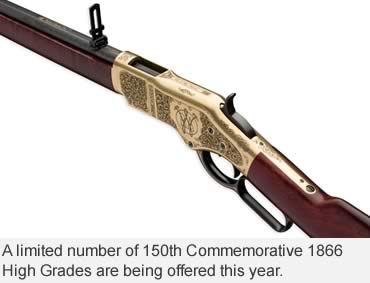 Out West, however, the great bison slaughter is underway, and Native Americans are fighting the advance of civilization. In 10 years, they will impress their rage upon Gen. George Armstrong Custer and the 7th Cavalry, delivered in part by a groundbreaking repeating rifle that first appeared in 1866.
Out West, however, the great bison slaughter is underway, and Native Americans are fighting the advance of civilization. In 10 years, they will impress their rage upon Gen. George Armstrong Custer and the 7th Cavalry, delivered in part by a groundbreaking repeating rifle that first appeared in 1866.
This rifle is the product of a new company owned by, of all persons, a dress shirt manufacturer. Over the next 150 years, Oliver F. Winchester will become synonymous with American firearms and ammunition.
Model 1866 Yellow Boy
Lever-action rifles are eternally linked to Winchester, yet he never designed one. He manufactured men’s shirts, but was smart enough to invest in the New Haven Arms Co. (1857-1866,) which built the original Henry lever-action repeating rifle used sparingly during the Civil War.
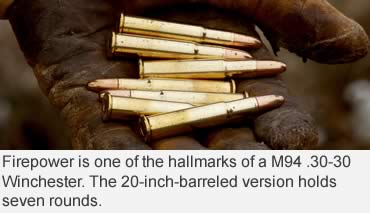 The Henry looks like a Winchester without a fore-end stock. It evolved from the Volcanic lever action — an improved version of the Jennings — itself an improvement over the original Hunt Volition Repeating Rifle of 1848. Innovative firearms don’t just pop up fully formed like mushrooms.
The Henry looks like a Winchester without a fore-end stock. It evolved from the Volcanic lever action — an improved version of the Jennings — itself an improvement over the original Hunt Volition Repeating Rifle of 1848. Innovative firearms don’t just pop up fully formed like mushrooms.
What the Henry did that its predecessors did not was fire a cartridge containing the firing compound and powder. This was the .44 Henry Flat rimfire, one of the first self-contained cartridges essential in making the repeating rifle work. Each copper case held about 27 grains of blackpowder, enough to drive a 200-grain bullet 1,100 fps.
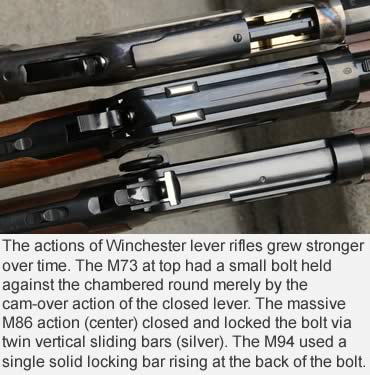 After Winchester bought controlling interest in New Haven Arms in May 1866, he changed the name to Winchester Repeating Arms and set Nelson King to work improving the Henry. King closed the magazine tube, mounted a walnut fore-end to insulate hands from the barrel and created a rear loading gate in the receiver. This enabled shooters to shove cartridges nose-first into the magazine tube rather than drop them base first down the muzzle end as required in the Henry.
After Winchester bought controlling interest in New Haven Arms in May 1866, he changed the name to Winchester Repeating Arms and set Nelson King to work improving the Henry. King closed the magazine tube, mounted a walnut fore-end to insulate hands from the barrel and created a rear loading gate in the receiver. This enabled shooters to shove cartridges nose-first into the magazine tube rather than drop them base first down the muzzle end as required in the Henry.
Winchester cataloged this rifle as the Model 1866 lever-action repeating rifle, but due to its colorful bronze/brass alloy receiver, folks started calling it the Yellow Boy. The long tube magazine beneath its 24-inch barrel stored 15 rimfire .44 Henry Flat cartridges. This was the rifle you could “load on Sunday and shoot all week.”
Pioneers, cowboys, lawmen and Native Americans embraced the new Winchester. At least 20 Yellow Boys were used by the Cheyenne and Sioux at Little Bighorn, even though by then, an even better Winchester was on the market.
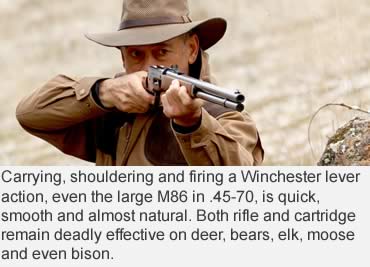 Today’s Commemorative Model 1866
Today’s Commemorative Model 1866
This new Yellow Boy is mechanically faithful to the original, except it now shoots a .44-40 centerfire cartridge. In 2016, only an elaborate Commemorative Edition with extensive scroll engraving, gold inlays, crescent brass buttplate and custom grade walnut stock will be sold at an MSRP of $3,329.99. Plainer models will become available later. The Commemorative sports a 24-inch octagonal barrel with ladder-style carbine rear sight. The magazine will hold 13 rounds.
Model 1873: The Gun That Won The West
Even while the Model 66 was selling, Winchester engineers were experimenting to make it better. The upgrade released in 1873 was built on an iron action, soon upgraded to steel with a sliding dust cover over the action.
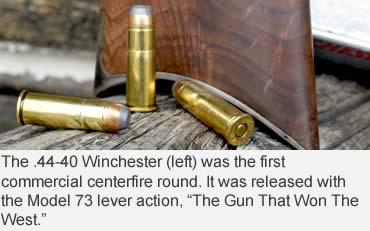 The biggest improvement was what the rifle fired: the .44 Winchester Center Fire, aka .44-40 Win, the first commercially successful centerfire cartridge. Soon chambered in Colt revolvers as well, this round burned 40 grains of powder to propel a 200-grain bullet at an average 1,200 fps from a rifle.
The biggest improvement was what the rifle fired: the .44 Winchester Center Fire, aka .44-40 Win, the first commercially successful centerfire cartridge. Soon chambered in Colt revolvers as well, this round burned 40 grains of powder to propel a 200-grain bullet at an average 1,200 fps from a rifle.
Spent cases could be reloaded, and Winchester soon sold a pliers-type reloading tool to do this. Slightly more powerful than the .44 Henry flat, the .44-40 was no powerhouse but proved adequate for tackling deer, pronghorn and even elk if used judiciously. Its versatility appealed to pioneers, cowboys, ranchers, lawmen and outlaws. More than 720,000 M73s were sold, and it became “The Gun That Won The West.” Buffalo Bill Cody used a 73 to conduct trick shooting in his Wild West shows.
 Today’s M1873
Today’s M1873
A special Commemorative model with checkered, fancy grade walnut, deep relief scroll engraving, gold embellishments, 24-inch octagon barrel and tang-mounted peep sight will be offered in .44-40 in limited numbers for 2016, MSRP $3,329.99.
A Sporter version sans checkering or fancy walnut also has a 24-inch octagon barrel, but is mounted with classic buckhorn open sights. The steel action forearm cap and crescent butt plate are case color hardened. MSRP $1,739.99.
A carbine version with plain walnut stock and blued action is fitted with a 20-inch round barrel (MSRP: $1,299.99), and the same rifle with case-colored action sells for $1,579.99. Each of these versions will be chambered for .44-40 plus .357 Mag/.38 Special and .45 Colt.
Model 1976
In order to accommodate larger, more powerful cartridges (such as .45-75 Winchester, .40-60 and .50-95 Express), the M1873 was scaled up. This was probably the only Winchester used in any numbers by commercial bison hunters. Texas Rangers and Canadian Mounted Police also carried M76s, and Geronimo owned one when he surrendered in 1886, but the real Winchester lever-action powerhouses were still to come.
Today’s M76
Not being built.
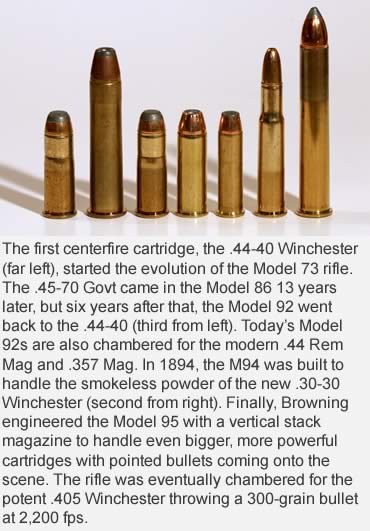 Model 1886
Model 1886
This was Winchester’s first John Moses Browning-designed lever action and a significant mechanical departure from earlier lever actions. Original Winchesters sealed the breech with a small bolt locked into place with little more than the cam-action of the toggle lever when closed. While this is more than adequate for relatively low-power handgun cartridges, it couldn’t contain the likes of the .45-70 Govt. Browning came up with a bolt that locked via twin steel bars sliding up from the lever through grooves in the action and into both sides of the massive breech block/bolt. The 1886 proved more than strong enough to handle the .45-70 Govt and .50-110. In 1935, it was modified slightly and built as the Model 71 firing the new, smokeless and extremely powerful .348 Winchester.
Today’s M86
You’ll find Winchester’s M86 in .45-70 with blued receiver and 24-inch round barrel for MSRP $1,339.99. It features buckhorn sights, a straight grip, tang safety, no checkering and a steel buttplate. The Deluxe model has a high-grade, satin-finished walnut stock and pistol grip, case-colored receiver and a 24-inch octagon barrel.
Model 1892
With Browning rolling out efficient new lever designs, Winchester had the chance to improve upon its old M73, and a downsized M86 was a slick way to do it. This model retains the mechanical design of the M86, including the dual rear locking lugs, but it’s scaled for the classic, short handgun cartridges popular in the M73.
Browning’s mechanism permitted construction of a slimmer, shorter, lighter and better balanced rifle than the M73. The M73 arrived a bit late for the wild, wild West, but it became the go-to rifle for Hollywood westerns and TV shows like “The Rifleman.” John Wayne performed with a lot more M92s than 73s or 66s.
Today’s M92
Winchester is selling modern M92s with tang safeties. Choose between the Large Loop model in .44 Rem. Mag., .44-40 Win and .45 Colt or Short Rifle in all but .44-40. Both versions are basic walnut/blued with 20 inch barrels.
Model 1894
Here, finally, is the acme of Winchester’s tubular magazine lever actions. Browning engineered this sleek, fast, nicely balanced rifle to handle the first commercial smokeless cartridges, the most famous of which is the .30 WCF or 30-30 Winchester.
The combination of this rifle and cartridge has been credited with taking more deer than any other rifle/cartridge in the world. More than 8 million M94s have been built. It’s respected as the ideal brush gun, yet is more than powerful enough for open country use to 200 yards or, in the right hands, to 250 yards. Recoil is more than reasonable, and power more than adequate. Many consider this the perfect balance for whitetails and mule deer, but plenty of elk, moose, caribou and bears have been taken with it.
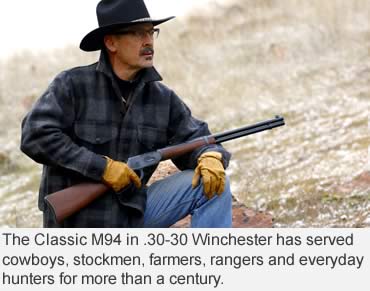 Today’s M94
Today’s M94
Same as always, except there’s a discreet tang safety. The 2016 Commemorative model sports cut checkering, fancy-grade walnut, scroll engraving with gold embellishments =on the cap, receiver, lever and steel buttplate, octagonal 24-inch barrel and a Marble’s Arm peep sight on the tang. MSRP $2,669.99.
For plainer tastes, there are several walnut/blued models with 20- or 24-inch barrels, round or half octagon, checkered or plain. There’s even a takedown model.
Model 1895
Winchester’s most powerful lever gun was the world’s first to employ a vertical stack magazine. As such, it has a clunky look, but certainly no clunky performance. Browning probably designed it to take advantage of the ballistically efficient bullets then becoming popular on the .30-40 Krag and 7x57mm Mauser. If so, he was prescient because the efficiency and power of those rounds propelled all of our rifles into the 20th century. It may have inspired Arthur Savage’s rotary magazine M99 lever action.
 The M95 was a heavy rifle, but strong enough to handle the .30-06 Springfield when it came along 11 years later. Teddy Roosevelt carried a M95 in .405 Winchester, his “Big Medicine.” Author Zane Grey was the proud owner of a heavily engraved, nickel-finish M95 currently on display at the Cody Firearms Museum.
The M95 was a heavy rifle, but strong enough to handle the .30-06 Springfield when it came along 11 years later. Teddy Roosevelt carried a M95 in .405 Winchester, his “Big Medicine.” Author Zane Grey was the proud owner of a heavily engraved, nickel-finish M95 currently on display at the Cody Firearms Museum.
The M95 is not currently manufactured by Winchester.
Miscellaneous Winchester Levers
Several slight variations of the M92 were marketed as the M53, 55, 64 and 65 between 1924 and 1957. The best-known of the bunch are the Model 64, which was chambered for .219 Zipper among others, and the Model 65 in .218 Bee.
None of these models is being built today.
The Lever-Action Mystique
Like so many kids who grew up during the cowboy craze of the 1950s and 60s, I took my first deer and pronghorn with a lever action. These rifles hold a special place in my heart, but there are more reasons than nostalgia for shooting one today.
In addition to being a huge part of the rifleman’s heritage, Winchester lever actions remain ideal tools for hunting and even self-defense. Google “The Rifleman” and you’ll see how quickly a practiced shooter can pour rounds through a lever action.
With a magazine holding 10 or more handgun rounds, you have plenty of quick firepower in a rather old-fashioned-looking rifle that won’t inspire the ire of black gun haters.
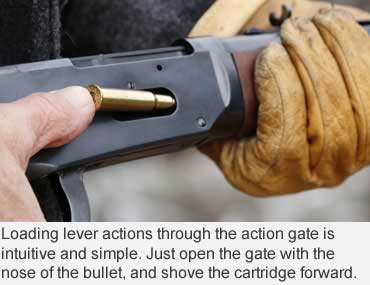 Try a lever action, and you’ll discover how effective they can be for hunting, too. If you stick to open sights, the handgun cartridges add an extra challenge when hunting small game, coyotes, deer, hogs and pronghorns out to 100 yards.
Try a lever action, and you’ll discover how effective they can be for hunting, too. If you stick to open sights, the handgun cartridges add an extra challenge when hunting small game, coyotes, deer, hogs and pronghorns out to 100 yards.
The M94 .30-30 with modern ammunition is flatter shooting and harder hitting than ever. The M94 is still the ideal brush gun ,and a high-volume pig poker when doing animal damage control in tight quarters.
You can’t beat the slab-sided lever for packing in a scabbard on a horse or four-wheeler, either. At 6.5 pounds, it’s a short, easy rifle to carry when scrambling though mountain rocks and forests in pursuit of cougars and black bears.
There probably isn’t anything a lever action can do that more modern actions can’t — except looking cooler while doing it.
For 150 years Winchester lever-action rifles have been major contributions to shooting and hunting success — and fun.
This article was published in the May 2016 edition of Buckmasters GunHunter Magazine. Subscribe today to have GunHunter delivered to your home.